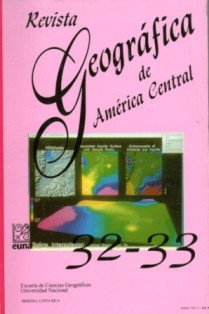ORDENAMIENTO DEL TERRITORIO LOCAL ASISTIDO A TRAVES DE UN SISTEMA DE INFORMACIÓN GEOGRÁFICA.
Abstract
El presente artículo muestra la aplicación de un Sistema de Información Geográfica (SIG) con una interfase con manejador de base de datos. El SIG utilizado es de modelo raster sin la capacidad de desarrollar una base de datos descriptiva.
La aplicación desarrollada es conocida como Sistema de Información Geográfica para Gobiernos Locales (SIGGLO)y el área donde se implementó fue en el cantón de santo Domingo de la provincia de Heredia.
En el apartado Los Planes de ordenamiento Territorial se discute sobre la utilidad que posee este tipo de instrumentos, que regulan el ordenamiento a nivel local y en forma paralela los autores presentan sus inquietudes del porqué los planes reguladores no han tenido el éxito deseado.
Posteriormente, se presenta la visión de los autores sobre Los Planes de ordenamiento Manuales vs. Automatizados, el cual permite presentar las ventajas y desventajas que poseen los SiGs para implementar un Plan de Ordenamiento a través de esta tecnología.
Seguidamente se presenta en detalle la experiencia obtenida con el SIGGLO, donde se explica la utilización del SIG y de un paquete de digitalización para combinar luego ambos con un manejador de bases de datos.
Por último, se presentan una serie de restricciones que tiene el SIGGLO, también las recomendaciones que se deberían considerar al implementar un nuevo proyecto bajo la metodología del SIGGLO.
ABSTRACT
The present article presents an application of a data base management system interfacing with a Geographical Information System (GIS). The utilized GIS for the project is a raster based system without the ability to develop a descriptive data base. This system is called Geographical Information System for Local Governments (SIGGLO) and was implemented in the canton of Santo Domingo, Costa Rica.
It is mentioned in Territorial Organization Plans the utility that GIS systems have in regulating organization on a local level. In parallel form, the authors present their doubts of why these regulatory plans have not had the desired success.
Afterwards, the authors present their vision of an Organization Plan for Manual and Automated functions which permit the presentation of the advantages and disadvantages that contain GIS in order to implement a Organization Plan with these technologies.
Following this is a detailed presentation of the experience obtained with SIGGLO and where it is explained the utility of the GIS and of a digitizing software package which was later combined in the data base management system.
Finally, a series of restrictions is presented that SIGGLO has which also contains details of recommendations that should be considered upon implementing a new project under the SIGGLO methodology.
Downloads
How to Cite
Issue
Section
License
Proposed policy for journals offering Open Access
Authors publishing their works in the Journal acknowledge and agree to the following terms:
a) Authors retain the copyrights to their works and guarantee the Journal the right to be the first to publish their works, under the Creative Commons License Attribution-NonCommercial-ShareAlike 4.0 International, CC BY-NC-SA 4.0 International (https://creativecommons.org/licenses/by-nc-sa/4.0/deed.es), which allows others to share works upon complying with the acknowledgment of authorship and mention of the Journal as the original publisher of the work.
b) Authors are permitted to separately establish additional agreements for the non-exclusive distribution of the official edition of the work published in the Journal (for example, authors may desire to place the work in an institutional repository or incorporate it into a book that is to published elsewhere) so long they acknowledgment to recognize the Journal as the original publisher. The aforementioned additional agreements must respect the terms of the non-profit character and sharing philosophy of the original license (CC BY-NC-SA 4.0 International, https://creativecommons.org/licenses/by-nc-sa/4.0/deed.es).
c) Authors are encouraged to archive the post-print or editor/PDF version in Open Access repositories.






 REVGEO is licensed under https://creativecommons.org/licenses/by-nc-sa/4.0/deed.es
REVGEO is licensed under https://creativecommons.org/licenses/by-nc-sa/4.0/deed.es
.svg_4.png)

_(1).png)
_(1)_(1)_(1)_1.png)
(2)(1)(1)(1).png)
